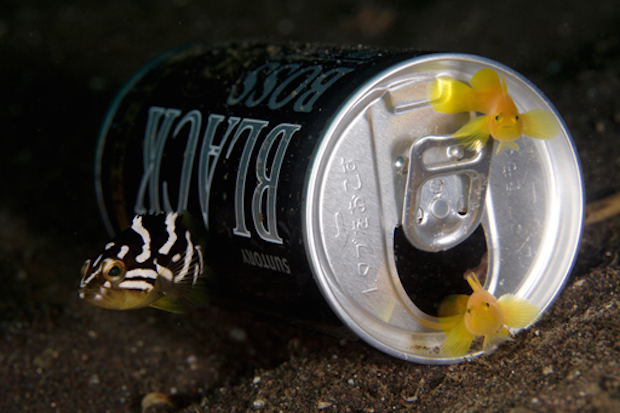One man’s trash is another man’s treasure. This doesn’t just apply to bipedal humans, but to many creatures in the animal kingdom. In the fishy world, man’s junk can sometimes find usefulness in the deep blue sea. Disclaimer* We feel strongly against harming our seas and we do not advocate ocean dumping and blatant littering in the ocean. Our reefs do not need anymore junk thrown in. This is just a light hearted post of fish living in relatively harmless rubbish.

Beer drinking fishermen on boats or party going beach goers offers an opportunity for land based aluminum cans to meet the deep dark ocean floor. An unlikely marriage of two worlds. Well, this phenomenon down under may provide a home for an equally unlikely duo. In this BLACK BOSS coffee can however, a juvenile Epinephelus radiatus has taken refuge alongside a pair of Lubricogobius exiguus.

A grouper and a pair of teeny tiny gobies living inside a drink can is indeed curious. Though still a juvenile, there is nothing stopping this rare grouper from eating the pair of gobies. The gobies on the other hand, seem unfazed and swim blatantly, even snuggling up alongside their grouper friend. One thing both have in common however, are their rarity, and well their apparent love for drink cans.
Epinephelus radiatus belongs to a group of very similar and closely related deep water groupers, and is often confused with E. poecilonotus and E. tuamotuensis. As juveniles, they make rare pets in the aquarium trade but as adults, they are commonly seen on ice in seafood markets. Lubricogobius on the other hand, is never eaten as food. It too rarely makes its appearance in the trade.

While sharing is caring, everyone likes to have a home of their own some day. Side by side beer bottles make good real estate for this pair of Meiacanthus kamoharai. Empty bottles are just as popular as beer cans in the fish world. Some fishes like their homes made of glass, while some prefer a more metallic shine to their abode. These two blennies opt for a more modern zing to their homes, and they do make good neighbors in this lovely neighborhood.

Some fish are picky, while some fish are just more carefree in their lifestyle choices. Different species in different rubbish they say. This is the motto adopted by Pristigenys niphonia. P. niphonia, or the japanese big eye, is a very rare and beautiful member of the Pristigenys genus.
The juveniles are a rusty red adorned with stripes, and as they grow into their adult coloration, adopt a more scarlet and sizzling red body. The white stripes do not go away with age and this makes P. niphonia one of the most beautiful of the big eyes.

P. niphonia is distributed in the Pacific Ocean, as well as the Indian Ocean. Those that enter the trade come from Japan or Sulawesi, and are caught from very deep waters. In the wild, they can be found in waters exceeding 250 ft. In the video we have linked above, you can see juveniles swimming around their soda can huts and plastic jar houses.

While some fish seek out human rubbish to throw parties in, or hide from headhunters, some prefer to settle down and raise a family. This young Lubricogobius dinah couple has found a lovely beer bottle in an expensive part of the reef to raise their young. It has a nice yard with seagrass for their young to frolic in, as well as a nice clear bottle to admire the view. L. dinah is closely related to L. exiguus above and below, but possesses a thick silvery white stripe on its dorsal region.


Lubricogobius are small enough to use such junk as potential breeding spots. This L. dinah above is tending to her eggs in which she has deposited in a plastic jar. A quick search online reveals that plastic is also choice housing material, with other tiny fishes living in plastic bottle caps even. A useless everyday item like a fizzy drink can or a jam jar may seem like nothing to you, but to these fish it can mean the difference between life and death. Of course, we don’t suggest you go around throwing all your junk in the sea. The fishes have enough to live in down there, and even if there were no more bottles and cans, there are things called rocks and corals. Natural homes for these beautiful fish, as below.




